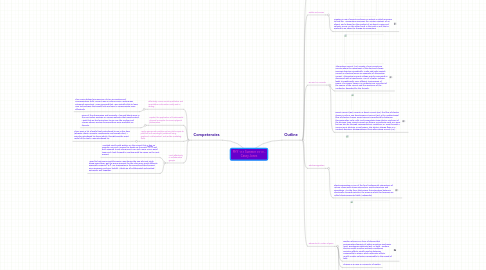
1. Outline
1.1. Electrical and Magnetic Properties of Matter
1.1.1. Electrical Properties of Matter: All matter is made up of atoms which consist of electrons (negative), protons (positive), neutrons (neutral) and a nucleus (contains protons and electrons). Coulomb’s law says that opposites attract, and the same charges repel. These attractions put the electrons in an orbit, but when they are released, they create an electron flow, which becomes an electric current.
1.1.2. Magnetic Properties of Matter: Magnetism is a property of matter and it occurs in different forms and degrees in various conductors and insulators. For example, at low temperatures, metallic systems exhibit either superconducting or magnetic order. The degree of magnetism (also called magnetization) of a substance is due to the intrinsic magnetic dipole moment of its electrons.
1.2. Fields and Forces
1.2.1. Newton's Law of Gravity and gave an activity in which we were to find the. Momentum measures the 'motion content' of an object, and is based on the product of an object's mass and velocity. Force, on the other hand, is the push or pull that is applied to an object to change its momentum
1.3. DC and AC Circuits
1.3.1. Alternating Current (AC) Circuits: These circuits are circuits where the movement of the electrical charge reverses direction periodically. Audio and radio signals carried on electrical wires are examples of alternating current. Alternating Current voltage may be increased or decreased with a transformer. Use of a higher voltage leads to significantly more efficient transmission of power. The power losses in a conductor are a product of the square of the current and the resistance of the conductor, described by the formula.
1.3.2. Direct Current (DC) Circuits: In direct current (DC), the flow of electric charge is only in one directionDirect current (DC) is the unidirectional flow of electric charge. Direct current is produced by batteries, thermocouples, solar cells, and commutator-type electric machines of the dynamo type. Direct current can flow in a conductor such as a wire, but can also be through semiconductors, insulators, or even through a vacuum as in electron or ion beams. The electric charge flows in a constant direction, distinguishing it from alternating current (AC).
1.4. Electromagnetism
1.4.1. Electromagnetism is one of the four fundamental interactions of nature, along with strong interaction, weak interaction and gravitation. It is the force that causes the interaction between electrically charged particles; the areas in which this happens are called electromagnetic fields. (Wikipedia)
1.5. Elements of Modern Physics
1.5.1. Modern physics is a form of physics that incorporates elements of either Quantum Mechanics (QM), Einsteinian Relativity (ER), or both. Modern physics usually involves extreme conditions; quantum effects usually involve distances comparable to atoms, while relativistic effects usually involve velocities comparable to the speed of light.
1.5.2. Charge as a noun is a property of matter.
1.5.3. Modern physics refers to any branch of physics either developed in the early 20th century and onwards, or branches greatly influenced by early 20th century physics. Modern physics often involves extreme conditions; quantum effects usually involve distances comparable to atoms while relativistic effects usually involve velocities comparable to the speed of light. Small velocities and large distances is usually the realm of classical mechanics.
2. Competencies
2.1. Effectively communicate qualitative and quantitative information orally and in writing.
2.1.1. This course helped me improve a lot on my writing and communication skills. Since it was an online course, writing was extremely important. I was surprised that I was actually able to learn new technologies that would help me learn to communicate more effectively.
2.2. Explain the application of fundamental physical principles to various physical phenomena.
2.2.1. Many of the phenomena and principles I learned about were in the neat video postings or various websites that David posted. I wish that we had more time to go over the Nuclear and Atomic physics portion because those were probably my favorite.
2.3. Apply appropriate problem-solving techniques to practical and meaningful problems using graphical, mathematical, and written modeling tools.
2.3.1. There were a lot of useful tools introduced to me in this class (glogster, dipity, animoto, mindmeister and google docs). I was also introduced to Skype which I thought was the most useful of the tools I was introduced to.
2.4. Work effectively in collaborative groups.
2.4.1. I worked mostly with Brittiny on the project that is due on Monday. Her and I seemed to divide up the work 50/50 and both seemed to get along great. Her and I were a very good team and I look forward to working with her again on the next project.
2.4.2. I used to hate group work because I was always the one who got stuck doing everything. But the group projects for this class were much different, especially projects 2 & 3. My teammates in the second and third project were awesome and very helpful. I think we all collaborated and worked extremely well together.
